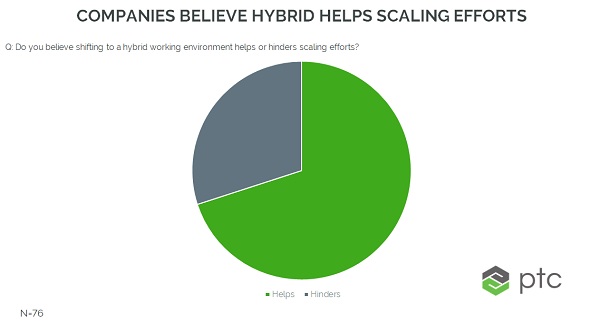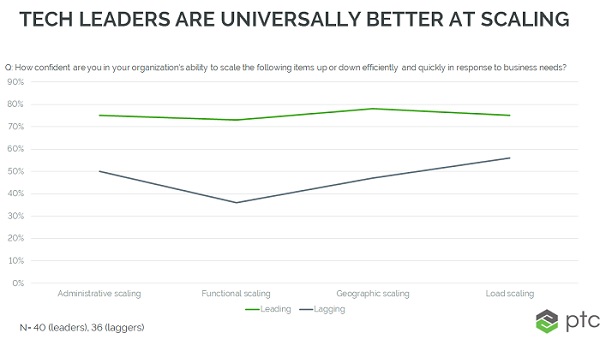Why SaaS Is Key to Improving Scalability
Creating a compelling product is difficult enough, but not the only point of failure for organizations. Even a winning solution may fall to the competition if its developer cannot get it into the hands of its audience. Scalability is a real challenge, especially for SMBs trying to breakout into larger operations, yet it comes in many forms:
- Administrative scaling: the ability to increase or decrease access to software tools for users or organizations
- Functional scaling: the ability to adopt or divest software functionality
- Geographic scaling: the ability to expand operations from a local area to a larger region or the downsizing or withdrawal of operations from specific regions
- Load scaling: the ability to expand or contract computing power to accommodate various workloads
Traditional logic says that scaling can be solved through financial investment, and this is still true. That said, as with any investment – there are optimal ways and suboptimal strategies. While many executives look for the next big competitive edge, sometimes it’s the least flashy solutions that are the most robust. For instance, many people like don’t think “I want to grow my business…I bet my software can help!” Yet, this is exactly one of the benefits software as a service (SaaS) provides.
SaaS: Thinking Beyond Software
While SaaS does directly refer to a software delivery and management system, its implications go far beyond the computer. Think about the traditional office in 2019. Workers came to a central location, whether headquarters or a branch, to perform their duties. The computing power and network access were all likely handled locally, either through the hardware itself on an on-premises server room. In a factory, this would still be the case. Workers would oversee production lines, making repairs and corrections as necessary – and again most networking and software would be housed and run onsite.
SaaS challenges part of this setup. By definition, it moves computing and data storage, and therefore the hardware, off-site. Server rooms are increasingly antiquated by comparison, as they require near-constant onsite supervision and maintenance. Anything, from an employee accidently adjusting the thermostat to a fire to a malicious attacker can all cause profound harm to an onsite server.
Since SaaS moves software management from the responsibility of the organization to the responsibility of the SaaS provider, far less routine observation and maintenance are necessary. This means, should an organization decide to scale geographically, they don’t need to worry about finding and setting up a new server room. They also don’t need to worry about purchasing additional processing power to enable new users to access the software.
SaaS also simplifies software usage in terms of functional scaling. In the previous model, new software meant that old software had to be uninstalled. Organizations don’t want employees using outdated processes that are incompatible with new solutions. This can be tricky with on-premises as it requires checking all hardware to ensure the old solution has been completely and successfully removed. With SaaS, the solution is never truly owned – only leased. This means it is updated automatically by the software provider. Organizations don’t need to worry about stragglers or mistaken employees accidentally booting up the wrong software – and if a new hire comes onboard, it is as simple as extending permissions, rather than installing and updating on yet another device. SaaS is deployed and removed seamlessly without becoming an enormously draining project for IT.
The Hybrid Advantage in Scalability
If all of this makes you think “why do you even need the office?” then you’re not alone. SaaS is such a fundamental shift in the ability to work that it has opened up flexible and remote working as not just an option but a preferable scenario in certain cases. In a 2022 survey, PTC asked executives and decision makers in a variety of industries how they thought hybrid working influenced scaling efforts. A whopping 70% stated they believe hybrid working environments benefit scaling capabilities.

It’s not difficult to see why. Geographical scaling alone sees tremendous barrier reduction. Want to expand to a new region? Hire a remote team that is local to that area. This doesn’t just apply for knowledge workers but field service employees as well. Reducing maintenance times can be a differentiator for hardware providers, and what sounds faster: “We’re sending someone from the home office to fix the tractor. Their plane leaves tonight.”
Or: “We have a local technician in the area. They can be onsite within two hours.”
The office has benefits, to be sure, but – as a defined physical space – it is also ripe with limitations. By expanding the definition of “office”, certain organizations are finding new productivity boons in decentralized workflow, and decentralized work is only sustainable with SaaS solutions.
Why Technological Leaders See Better Results in Scalability
For further proof into the positive causation of SaaS, decentralized workflow, and scalability, our recent survey separated respondents into categories. They were asked to intuitively declare their organizations as technological leaders – organizations rushing to embrace new technology and utilize the best innovation, or technological laggards – organizations that were not on the front lines of technology but rather preferred tried-and-true methods.
The results, which will be available in full in an upcoming whitepaper, paint numerous stark differences among the two groups. One of the most pronounced variations came in the relationship to remote and flexible working. Roughly 40% of leaders allowed at least some level of flexibility pre-pandemic, contrasted against only 20% of laggard organizations that said the same. Since leaders were already moving toward decentralized workflows – the pandemic’s shuttering of in-person work didn’t rattle them the same way that it did organizations that demanded in-person attendance. Leaders were already experimenting with and using SaaS solutions that empowered remote working. Neither the investment nor the mental shift were necessary for them to continue productivity.
And because of this increased use of decentralized SaaS solutions, leaders are showing an across-the-board advantage in scalability capabilities, regardless of the type of scaling in question. The difference was most pronounced in functional scaling, where only 36% of lagging respondents felt confident in their organization’s ability to quickly or efficiently scale. Nearly three-quarters of leaders (73%), by contrast, stated they believed their organization up to the task.

Versatility and agility are going to be key attributes going forward. Organizations that are rigid were already severely tested by the pandemic, and it should never be assumed that there will be no further mass disruptions going forward. The ability to scale quickly and efficiently is almost as important as the ability to be productive. Systems that can’t be altered or replicated have limited applicability.
Technological leaders have shown there are numerous advantages toward seeking decentralized solutions like SaaS, one of the largest being the ability to scale quicker and easier. For those SMBs out there brainstorming on organizational expansion, SaaS must be considered as not just a viable but a superior method toward achieving this goal.